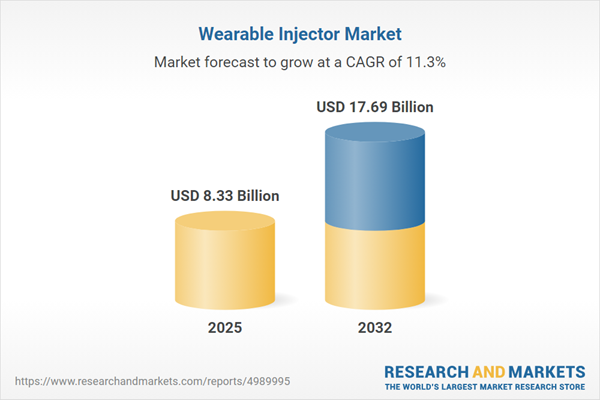Speak directly to the analyst to clarify any post sales queries you may have.
The wearable injector market is reshaping therapy delivery by providing healthcare executives with new pathways to modernize care, address decentralized treatment paradigms, and optimize service across diverse patient settings. Senior leaders will find this report essential for understanding the sector's evolving capabilities and for aligning with trends that support patient-driven outcomes and operational leadership.
Market Snapshot: Wearable Injector Market Size and Growth
In 2024, the global wearable injector market stands at USD 7.52 billion, reflecting robust year-over-year growth. This performance is driven by the accelerated adoption of self-administered therapies and strengthened by digital technology integration. Analysts project the sector to expand further, propelled by investment influx and continuous shifts in reimbursement frameworks. Stakeholder interest remains especially strong in disease areas requiring biologics and specialty drugs, as new administration models support transformative changes for clinical and operational workflows.
Scope & Segmentation in the Wearable Injector Market
Well-defined segmentation within the wearable injector market allows organizations to tailor strategic initiatives and investment. Leaders can maximize value by addressing the following segments and aligning with care delivery requirements across geographies and therapeutic areas:
- Product Types: Off-body injectors, adhesive on-body patches, and belt-clip devices provide options catering to patient comfort, usability, and clinical flexibility.
- Technology: Connected electronic injectors enable real-time remote monitoring, while mechanical designs prioritize intuitive usage. Digital integration and user-centric interfaces help drive adoption.
- Usage Models: Disposable solutions are preferred where infection control and one-time dosing are essential, whereas reusable devices are advantageous in long-term or chronic care programs seeking sustainability.
- Volume Ranges: Choices span small-volume to large-volume injectors, ensuring suitable dosing for varied clinical protocols and supporting patient cohorts with differing therapeutic regimens.
- Patient Demographics: Devices incorporate ergonomic features for adult, pediatric, and geriatric populations, directly supporting therapy adherence across age groups and physical capabilities.
- Primary Applications: Use cases center on chronic disease management, notably for conditions such as autoimmune disorders, diabetes (including GLP-1 and insulin therapies), and cardiovascular care in clinic and home settings.
- End Users: Hospitals, outpatient clinics, surgical centers, and home healthcare entities adopt these devices for both acute treatments and ongoing care delivery.
- Geographic Reach: Market presence spans the Americas, Europe, Asia-Pacific, and Middle East & Africa. Each region demonstrates unique drivers, from differing infrastructure readiness to localized regulation and varied patient needs.
- Market Participants: Activity is shaped by established medical device manufacturers and emerging firms, fostering a dynamic environment of product development and competitive innovation.
Key Takeaways for Senior Decision-Makers
- Digital integration within wearable injectors enhances therapy adherence, while supporting operational improvements through real-time insights and responsive intervention capabilities.
- User-centered device design empowers patients to manage therapies with reduced clinical oversight, aiding the transition towards decentralized and home-based care models.
- Compliance with evolving regulatory landscapes is vital for timely market entry and ongoing organizational adaptability in response to changing standards.
- Programmable injectors streamline clinical workflow and enable personalized dosing strategies, refining chronic disease management and operational effectiveness for care providers.
- Collaboration across device manufacturers, pharmaceutical partners, and digital health stakeholders advances integrated care solution development, supporting cohesive and scalable care delivery systems.
- Regional approaches to business models are critical for navigating distinct reimbursement rules, regulatory expectations, and support requirements, allowing organizations to mitigate potential risks from system variability.
Tariff Impact: U.S. Changes and Global Cost Considerations
Recent changes to U.S. tariffs on critical device components have prompted healthcare providers and suppliers to diversify their sourcing strategies. Developing stronger networks with domestic suppliers, alongside global partners, is vital for minimizing disruptions and reducing risk exposure caused by shifting trade policies.
Methodology & Data Sources
This market report combines confidential discussions with healthcare leaders, an in-depth review of current clinical literature, and regulatory documentation. Adoption patterns are cross-examined with official datasets and industry-validated metrics for robust analysis.
Why This Report Matters
- Delivers actionable benchmarks and best practices that help leaders integrate wearable injector solutions, enhancing operational performance and enabling scalable care delivery.
- Clarifies how ongoing policy and regulation changes affect both procurement and organizational strategy, supporting timely responses to global and regional shifts.
- Guides senior stakeholders in building partnerships and sustaining resilient growth amid the dynamic healthcare technology landscape.
Conclusion
Wearable injectors support healthcare organizations in elevating care quality and service flexibility. Decision-makers informed by this report can navigate market evolution with confidence and maintain an edge in advancing patient care.
Additional Product Information:
- Purchase of this report includes 1 year online access with quarterly updates.
- This report can be updated on request. Please contact our Customer Experience team using the Ask a Question widget on our website.
Table of Contents
3. Executive Summary
4. Market Overview
7. Cumulative Impact of Artificial Intelligence 2025
List of Figures
Companies Mentioned
The companies profiled in this Wearable Injector market report include:- Becton, Dickinson and Company
- Insulet Corporation
- Amgen Inc.
- CC Bio, Ltd
- CeQur Corporation
- DCA Design International Ltd
- Debiotech SA
- E3D Elcam Drug Delivery Devices
- Enable Injections, Inc.
- EOFlow Co., Ltd.
- Gerresheimer AG
- Kymanox Corporation
- LTS Lohmann Therapie-Systeme AG
- Medtrum Technologies Inc.
- NOVO Engineering, Inc.
- Shaily Engineering Plastics Ltd.
- SONCEBOZ SA
- Stevanato Group S.p.A.
- Subcuject ApS
- Viant
- West Pharmaceutical Services, Inc.
- Ypsomed Holding AG
Table Information
| Report Attribute | Details |
|---|---|
| No. of Pages | 189 |
| Published | November 2025 |
| Forecast Period | 2025 - 2032 |
| Estimated Market Value ( USD | $ 8.33 Billion |
| Forecasted Market Value ( USD | $ 17.69 Billion |
| Compound Annual Growth Rate | 11.2% |
| Regions Covered | Global |
| No. of Companies Mentioned | 23 |









